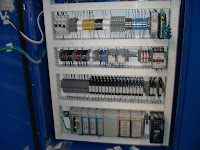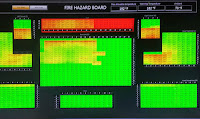
The purpose of fluid power is to transmit power from one location to another. In the mid-1600s Blaise Pascal, a French mathematician, made a very important contribution in the field of fluid motion. This contribution, known as
Pascal's Law, relates the transfer of pressure through a fluid. Pascale determined that a contained, pressurized fluid will exert pressure equally in all directions. Pascal's Law states that pressure set up in a confined body of fluid acts equally in all directions and always at right angles to the containing surfaces.
Another important property of fluid mechanics was discovered in the late 1600s by Robert Boyle, an Irish physicist.
Boyle's Law is an experimental gas law which describes how the pressure of a gas increases as the volume of gas decreases. A modern statement of Boyle's law is the absolute pressure of a confined body of gas varies inversely as its volume, provided it's temperature remains constant. In a physical system this means that as the volume decreases, the pressure increases. Similarly, as the volume increases, the pressure decreases. Boyle's Law can be expressed mathematically as the pressure at state 1 times the volume at state 1, is equal to the pressure at state 2 times the volume at state 2. This is true as long as both the temperature and mass, or amount of gas, remains constant.
In the late 1700s Jacques Charles, a French scientist and mathematician, discovered an important rule regarding gases under pressure.
Charles's Law, also known as the Law of Volumes, is an experimental gas law which describes how gases tend to expand when heated. It states that if the pressure of a gas is constant, and it's temperature is raised, the volume will also be raised by the same ratio. Additionally, the inverse is true. If the pressure of a gas is constant, and the temperature is lowered, the volume will also lower. Charles's Law can be expressed mathematically as the ratio of the temperature at state 1 to the volume at state 1, is equal to the ratio of the temperature at state 2 to the volume at state 2. This law is true as long as the pressure and mass remain constant.
In the mid-1700s, Danielle Bernoulli discovered another very powerful rule in the field of fluid mechanics. Known as
Bernoulli's Principle, this rule is related to the Theory of Conservation of Energy, which states that energy can neither be created nor destroyed. In this fluid system, pressure is potential energy and fluid flow is kinetic energy. Bernoulli's Principle states that an increase in the speed of an incompressible fluid occurs simultaneously with a decrease in pressure.
Toward the end of the video below, this is illustrated by the flow of water through a pipe. The volume of water flow through all three sections is the same when the waters flow is restricted. In Section B, the speed of the water increases to maintain the same amount of volumetric flow. This increase of speed simultaneously causes a decrease in pressure. When the flow of water reaches section C, the inverse occurs. The water flow decreases and the pressure increases. This rule can also apply to the types of energy present in the system. As the pressure decreases in Section B, the potential energy converts into kinetic energy. This increases the speed of water flow and decreases the pressure. When the water reaches section C, the kinetic energy is converted back to potential energy. This is illustrated by the decrease in speed of the water flow and it's simultaneous increase in pressure.
https://processcontrolsolutions.com













